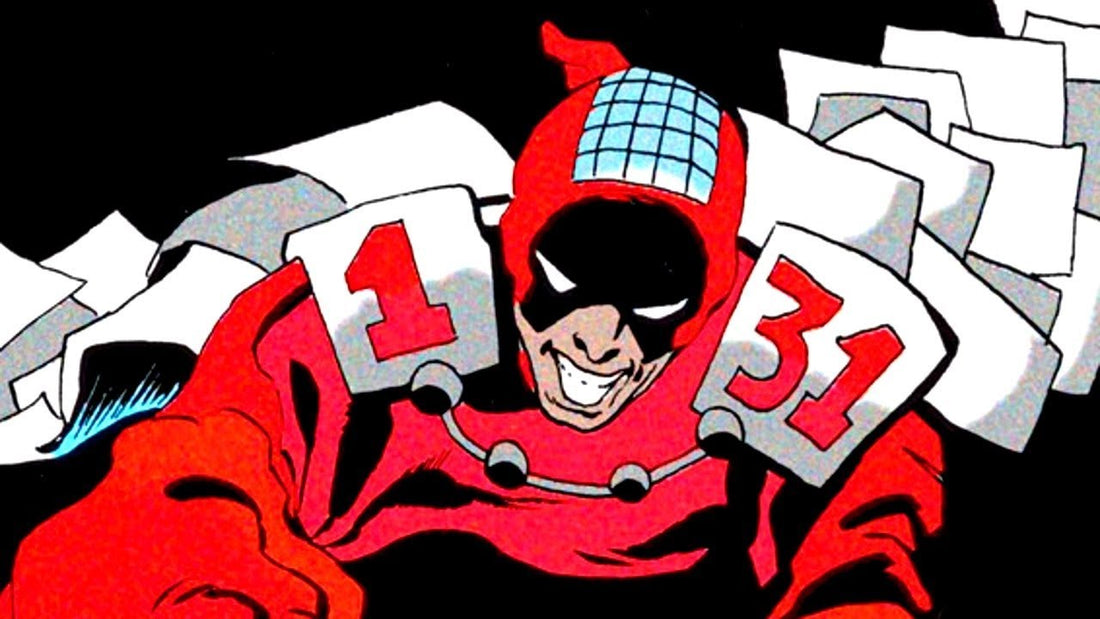
Calendar Man: An underestimated but terrifying enemy in comics
When we think of Batman 's enemies, the first names that come to mind are the Joker , Two-Face, or the Scarecrow. However, a much more discreet but formidable adversary haunts the alleys of Gotham: Calendar Man , aka Julian Day. Behind his almost banal appearance hides a chilling obsession: time and dates.
Introduced in comics in the 1950s, Calendar Man is often seen as a supporting character. Yet his meticulously planned crimes, timed around holidays, seasons, and symbolic dates, make him an unpredictable and terrifying enemy. His ability to weaponize the calendar demonstrates that Gotham doesn't need super-powered monsters to be plunged into fear.
This methodical criminal reminds us that danger lies not only in the chaotic madness of the Joker or the brutality of Bane, but also in the clinical precision of an obsessed mind. His role in landmark stories like The Long Halloween has cemented his reputation, making him one of the most underrated antagonists in the Batman universe.
👉 To explore other equally fascinating adversaries, discover our pillar page dedicated to Batman's enemies , as well as our analyses of Two-Face and the Scarecrow , two equally emblematic figures of Gotham.
The origins and first appearances of Calendar Man
Julian Day, aka Calendar Man , made his first appearance in Detective Comics #259 in 1958. At the time, the character was introduced as an eccentric criminal whose criminal activities followed a theme related to the seasons, holidays, or calendar cycles. His costumes changed depending on the day he committed his crimes, giving him a theatrical yet eerie appearance.
While his beginnings may have seemed lighthearted, almost close to the caricature of the colorful villains of the time, Calendar Man evolved very quickly. In the 80s and especially the 90s, the writers reinvented the character in depth to make him a much darker, more intelligent and calculating figure. It was no longer just a gimmick based on dates, but a true unhealthy obsession with time and its symbols.
The work that truly cemented his role in the Batman universe was undoubtedly Batman: The Long Halloween (1996-1997), written by Jeph Loeb and illustrated by Tim Sale. In this cult classic, Calendar Man is imprisoned in Arkham Asylum but acts as an enigmatic advisor to Batman, similar to Hannibal Lecter in The Silence of the Lambs . He knows secrets, manipulates information, and subtly guides the Dark Knight in his investigation, marking a major turning point in his portrayal.
This evolution transformed Calendar Man into a psychological criminal, obsessed with the repetition of time and the inevitability of cycles. Unlike enemies like the Joker, who embodies chaos, or Ra's al Ghul, who represents immortality, Julian Day is an allegory of time passing , of death inevitably returning, making his crimes all the more symbolic and disturbing.
👉 If you want to explore other characters who, like Calendar Man, play on psychology and symbolism, check out our article on the Scarecrow or our analysis of Hugo Strange , two figures obsessed with fear and the psychology of the Dark Knight.
Calendar Man in Modern Narratives: From Background to Psychological Icon
While Calendar Man was long seen as a secondary villain, he took on a new dimension with Batman: The Long Halloween . In this seminal work, he isn't the main antagonist, but his role is reminiscent of Hannibal Lecter: imprisoned in Arkham, he guides Batman through cryptic clues concerning the identity of the Holiday killer. His obsessive knowledge of time and dates makes him a unique witness to the crimes that rock Gotham.
His presence is brief, but it is enough to reinforce the character's disturbing aura. He no longer acts as an extravagant criminal with colorful costumes, but as a master manipulator, cold and cerebral . This rewriting marks a decisive turning point and inspires all his subsequent incarnations.
Julian Day is also featured in the Batman: Dark Victory series, where he continues his role as a menacing shadow, reminding Batman and the reader that time is an inevitable enemy. More recently, he appears in the Arkham series video games. In Batman: Arkham City , he is locked in a cell, reciting gruesome riddles related to each holiday in the calendar. Players must return to see him on specific dates to unlock his dialogue, reinforcing his obsessive and unpredictable side.
Calendar Man thus embodies a less physical threat than enemies like Bane or Killer Croc , but his power lies in his psychological and symbolic dimension . Where other villains attack the body, Julian Day attacks the mind, with his chilling words and morbid obsessions.
👉 To extend this dive into Gotham's cult stories, you can consult our pillar page on Batman's enemies , where Calendar Man rubs shoulders with more famous figures like the Joker, the Scarecrow and Poison Ivy.
An underestimated enemy, but a strong symbol
Calendar Man perfectly illustrates the depth of Batman's villain gallery . While he lacks the notoriety of the Joker or the brute strength of Bane, he represents a different threat: that of time, inescapable and oppressive. His transformation from a criminal with an almost kitschy concept to a disturbing figure worthy of psychological thrillers proves that even DC's supporting characters can become cult classics.
In the collective imagination, Calendar Man reminds us that every date can carry dramatic weight . His calendar madness echoes the traumas of Gotham, a city where every day can be marked by tragedy. This is what makes him a terrifying enemy despite his lack of superpowers.
📚 For comic book fans, his appearances in The Long Halloween and Dark Victory are must-sees. And for gamers, his dialogue in Arkham City remains an immersive experience that pays homage to his unique obsession.
🎭 If you want to extend your immersion in the Batman universe, explore our Batman figurines , find a Dark Knight costume to embody your favorite hero, or complete your interior with a Batman poster inspired by the greatest comics.
Calendar Man may not be Gotham's most well-known villain, but he remains a vital piece of the puzzle. In battling him, Batman isn't just fighting a criminal, but an idea: that time always catches up with each of us.
